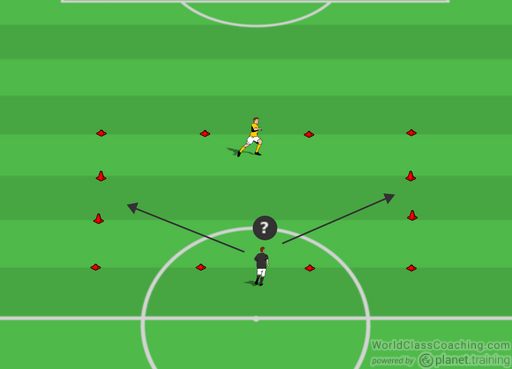ADVANCED 1V1 TRAINING
By Stefano Santona
In this book we're going to explore some debates regarding issues related to the 1v1.
Many people might think that it is a small part of football, but we find that in teaching 1v1, there are many important and aspects of concern that need to be considered.
Many people may think that the 1v1 is more useful to train with one age group rather than with another age group.
These ideas can be controversial. Here I will try to explain the topic, including these issues, in a practical way, with an explanation and some sample exercises.
If football is a team game, it is also a situational sport and so we have to evaluate the aspects that make it so. When we define a game a "situational sport" we see that, regarding 1v1 situations, the main aspects are:
• Frontally facing the opponent
• The concept of attack/defense
• Anticipation of the players movements
At the same time, however, we must enter into the technical aspects that interest us.
Within any 1v1 situation, the technical fundamentals are:
• Stopping and ball control
• Passing or shooting (because a 1v1 duel ends with another technical skill. Pragmatically, 1v1 duels always contain another element)
• Heading (it's still a 1v1)
• Bypassing or getting behind the opponent
• Bribbling of the ball before, during, and after the duel
Furthermore, we recollect that a player’s coordination capacity is his or her ability to perform an act with an harmonious and economical use of energy. So, in addition to the aspects mentioned above, we need to analyze and consider some aspects of coordination skills that are trained in 1v1. These include:
• Control and direction of movements
• Adaptation of the technical gestures to all 1v1 situations
• Learning the movement
• Coupling and combination of movements
• Kinesthetic differentiation
• Static and dynamic balance
• Space-time orientation
• Rhythm
• Simple and complex reactions
• Transformation of the movement
• Accuracy and speed of movements
• Managing the operations in different conditions and situations
• Management of the ball
• Management of time in relation to many variables, such as pressure and different spaces between players and on the field
Let us look in more depth at some items in this list:
Kinesthetic differentiation:
This is when an athlete achieves, in different ways, movements on the basis of perceptions of time, space, and applied strengths.
Kinesthetic differentiation skills included in football:
• Touching the ball with the optimal strength related to the situation on the field
• Skills related to the reception of the ball
• Evaluating the trajectory of the ball
• Sending the ball into a space or into the goal
• Evaluating the properties of the ball
• Relaxing the unnecessary muscles involved in a movement
Static and Dynamic Balance:
This is the player’s ability to keep the body in balance within its base of support (static equilibrium) or to maintain or restore balance during and after large movements of the body (dynamic equilibrium).
In football, we are talking of dynamic equilibrium in the majority of the situations, specifically:
• Maintaining balance in the struggle/duel for ball possession
• Maintaining balance in spite of the opponent's fake
• Maintaining a stable body position during shooting
• Stopping the ball by jumping
• Rapidly recovering after losing balance
• Quickly recovering balance while performing a series of fakes
Space Time Orientation:
This is the player’s ability to change the position and the movement of their body in space and time related to a well-defined field of action.
In football:
• Movement adaptation with respect to the point where the ball will come
• To choose the exact spot in which to belong on the field with respect to the trajectory of the ball and the situation
• Ability to send the ball exactly in the most appropriate point
• Simultaneous control of ball movement and player
Rhythm:
Ability to organize muscle commitments in chronological order.
In football: harmony between the ball movement and movement of different body parts (dribbling).
Reaction skills:
Ability to react to particular stimulus in response to a signal with adequate body actions.
In football:
• To respond quickly to the trajectory of the ball
• Appropriate reaction to external information (teammates, goalkeeper, coach, etc.)
• Rapidly transitioning from a static position to a dynamic movement related to the ball’s and players' movement
• To have movements adapted to different speed and movement of the ball
Segmentation skills:
Ability to coordinate movement of different body areas.
In football it is a link between ball, fakes, passes, dribblings, shot on goal, etc.;
For example:
• Receiving and passing the ball by jumping
• Combination of more than one action
• Aerial shot on goal
Symmetry skill:
In football we talk about using the non-dominant foot.
We have:
• Improvement of non-dominant foot skills;
• Improvement of dominant foot skills (brain's horizontal transference);
So, concluding the introduction, we see that success in a 1v1 situation depends on the simultaneous presence of many qualities that are complex and global.
The coordinated and conditioned abilities, in football, are integrated in a complex way:
1. Execution of a shot (power transmission) in precarious equilibrium (coordination)
2. How to do something by changing the strength of commitment (coordinative capacity of differentiation)
3. To go around the opponent (speed + technique + balance + rhythm)
4. To brake and change direction (eccentric strength in precarious balance conditions)
5. To accelerate quickly replying to a stimulus (speed + reply skill)
We can therefore say that all motor skills (conditional and coordinative) are integrated in a complex way to handle the requirements imposed by the game. This results in an individual player’s sense of the ball: "... The ability to adapt and shape the movements and the muscular efforts, on the basis of perceptions (players, ball, areas, goals, etc.).”
In summary, the best thing is to be in the right place, at the right time, with the optimal control of energy needed for the performance.
Besides the physical dimensions of 1v1, players and coaches must also take into account that 1v1 work is also a psychological task; we are working on the development of personality.
When coaches want to develop the 1v1 skills of their players, a continual process of change needs to be implemented. Coaches and players need to consider their own:
1. Awareness: to be aware of their skills in a 1v1 situation
2. Desire: desire to improve their skills in a 1v1
3. Research: research tools and the means to make the change
4. Commitment: to work actively to achieve the purpose
The coaching staff of a team will have to identify which aspects they will have to spend more time on.
PROGRESSION OF 1V1
EXERCISES FOR IMPROVEMENT IN BEATING THE OPPOSITE PLAYER
CHAPTER 1
Exercises without ball for improvement in bypassing the opposite player, achievement of the space, and finding the goals
1 VS 1 "MIRROR" GAME
Area Size:
Different geometric shapes (square, rectangle) depending on the focus. Vary the width or length size depending on the age and technical quality of the players.
Time:
5-10 minutes
Objectives:
• To create space
• To run fast in the created space
• Movement of the players related to the opposite player
• Just a little bit of fitness work involving change of direction
Execution:
This exercise is about the ability to create the space without the ball, in relation to the decision of the defender.
The striker has to run past the line behind the defender, but if the defender touches the striker with his hand, he scores the point.
It is important to play a very fast game (so 10-15 minute max, related to age of the player and area size).
1 VS 1 "MIRROR" GAME
1st OPTION
Working on length

1 VS 1 "MIRROR" GAME
2nd OPTION
Working on width

1 VS 1 "MIRROR" GAME
3rd OPTION
Working on width twice
In this progression we have to play 1v1 twice.
The striker has to choose what to do twice.
This is more difficult than the previous exercise because now the second defender has got the time to interpret and adapt to the action.
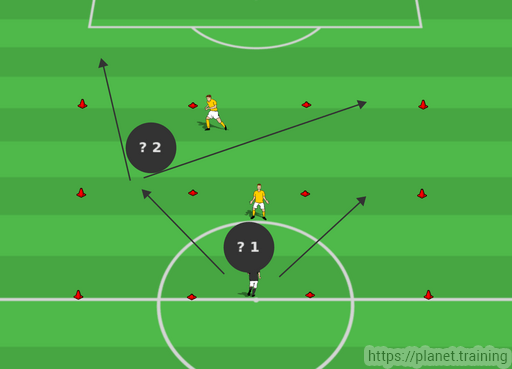
1 VS 1 "MIRROR" GAME
4th OPTION
Working on width and length
Now we have to play 1v1 three times.
The striker has to choose what to do twice on width and one time on length.
This is more difficult than the previous exercise because now the striker has to resist more fatigue.
This pattern is particularly interesting because, even though it is a progression of the previous exercises, it is more related to football because it recreates a real action (work on width on the middle of the field and work on length on the last part of the field).
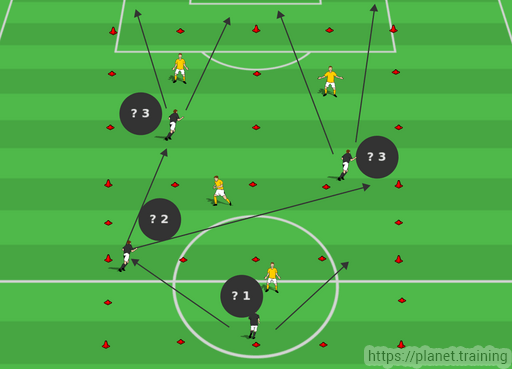
1 VS 1 "MIRROR" GAME WITH GOALS
Area Size:
Different geometric shapes (square, rectangle), depending on the focus. Vary the width or length size depending on the age and technical quality of the players.
Time:
5-10 minutes
Objectives:
• To create space
• To run fast in the space created
• Movement of the players related to the opposite player
• Just a little bit of fitness work involving change of direction
Execution:
This exercise is about the ability to create space in relation to the decisions of the defender and the goal's location.
The striker has to pass through the goal behind the defender, but if the defender touches the striker with his hand he scores the point.
The difficulties are increasing. Now we have only two little spaces in which to score a point and the defender knows that he has to cover those two little spaces and not the full width of the line.
It is important to play a very fast game (so 10-15 minute max, related to age of the player and area size).
1 VS 1 "MIRROR" GAME WITH GOALS
1st OPTION
working on length
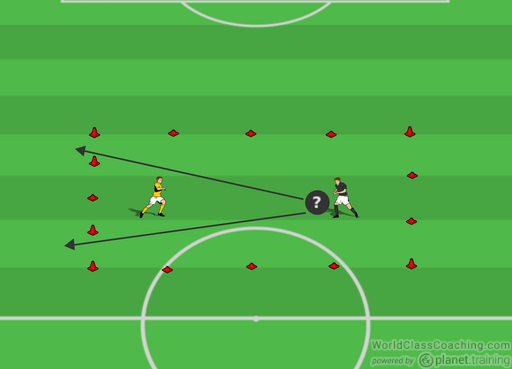
1 VS 1 "MIRROR" GAME WITH GOALS
2nd OPTION
working on amplitude and width
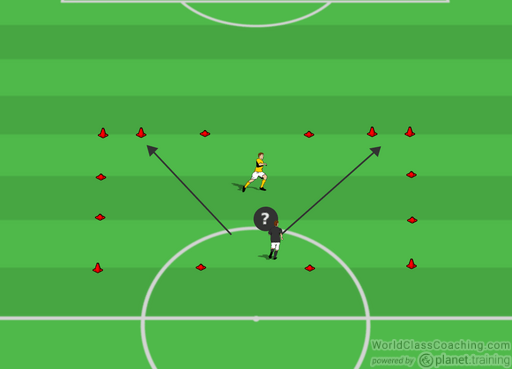
1 VS 1 "MIRROR" GAME WITH GOALS
3rd OPTION
working on spaces located on lateral sides (30° working angle).
